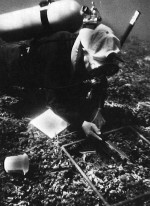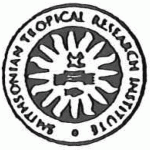The first in a series of articles on the Smithsonian Institution’s long-term ecological research sites
In a sense, the history of long-term ecological research in Panama began over three million years ago, with the final closing of the Isthmus of Panama. This event created a barrier between previously contiguous marine biotas of the Atlantic and Pacific Oceans, and created a land bridge for the interchange of previously isolated terrestrial biotas of South and North America. This geological and biological revolution provides the historical context and, in many cases, the primary motivation for research at the Smithsonian Tropical Research Institute (STRI).
Biological exploration of Panama began in the 1500s and has continued into the late 20th century; large areas of Panama remain biologically unknown. However, it was the construction of the Panama Canal in the early part of this century that catalyzed quantitative, long-term studies of tropical forest plants, animals and environment. The damming of the Chagres River produced Gatun Lake, which in turn created the Barro Colorado Island (BCI), the largest island in the Lake.
The large intact plant and animal communities on BC attracted the naturalists and researchers, who established it as a biological reserve in 1923. A laboratory/dormitory was built in 1924, and immediately began attracting professional researchers who initiated systematic surveys of the fauna and flora and behavioral studies, and established a climatic monitoring program. The reserve was administered by the National Academy of Sciences along with the Smithsonian and other institutions until 1946, when it was transferred to the Smithsonian Institution, under the management of STRI.
In 1977 the adjacent mainland peninsulas were added to BCI to form the Barro Colorado Nature Monument (BCNM), with a total of 5,400 hectares of Tropical Moist Forest. The peninsulas are used for experimental studies and collecting, while BCI is maintained as a strict reserve. The adjacent Soberania National Park provides an additional 22,000 hectares to the east of the BCNM. This park is connected to pacific dry forest in the Metropolitan Nature Park near Panana City by a protected forest corridor.
Barro Colorado Island has over 1,300 plant species, with published floras on vascular plants, bryophytes and pollen. A seed and seedling flora for the Island is in preparation.
There are 366 bird species, 56 bat species, and a primate species, with 465 species of vertebrates in all. Over 1,000 species of true bugs, 1,000 species of leaf hoppers and plant hoppers, and 100 species of cockroaches have been collected on the island. Two hundred species of ants are known.
Barro Colorado Island now has modem living space and air-conditioned laboratories for up to 35 researchers, with many additional scientists and assistants commuting to the island daily. Smithsonian Tropical Research Institute headquarters in Panama City maintains one of the most complete tropical biology libraries in the world, with over 1,000 journal subscriptions. Modern facilities for studies of physiology, biochemistry, molecular evolution and behavioral ecology are available, along with logistical support for visitors and resident scientists. There is a permanent scientific staff of 29 researchers. Several hundred students and senior scientists visit STRI for varying periods every year, many on Smithsonian fellowships. Barro Colorado Island is protected under international law, and managed by STRI under agreements with the Republic of Panama. The Institute was granted International Mission status by the government of Panama in 1985. This continuous, very long-term protection, combined with the scientific and logistical support of STRI, makes BCI one of the preeminent sites for tropical forest research.
Research Program
Many studies on BCI have continued for 10 to 20 years; climatic data and inventories of birds, mammals and plants extend back to the 1920s. Monitoring of climatic and edaphic factors, and of selected species or guilds of lizards, birds, mammals, insects and plants are supported by the Smithsonian’s International Environmental Sciences Program, which guarantees project funding for five years with the expectation of repeated renewals.
Center for Tropical Forest Science
The Smithsonian Tropical Research Institute recently established the Center for Tropical Forest Science, with Harvard and Princeton Universities, to support long-term and large- scale studies of tropical forest dynamics and management throughout the tropics. The primary focus of the Center is the establishment of 50-hectare mapped plots in many different forests. In each plot, every tree over 1 cm in stem diameter is marked, measured and identified. The plots are resurveyed every five years, with two years of post-treatment monitoring. Phenology, demography and physiology were followed for representative species, along with microclimatic and edaphic factors.
As part of the study of forest dynamics, STRI has pioneered the study of canopy biology— physiology, phenology, plant-animal interactions, climatology and related studies—using a construction tower crane. A prototype crane has been in successful operation for over a year in the pacific dry forest near Panama City. It provides extensive data on the responses of canopy trees and lianas to seasonal and shorter-term variations in light, temperature and humidity, and on the seasonal and spatial patterns of stingless bees. The crane provides safe, rapid and non-destructive access to over 122,000 cubic meters of forest.
Marine Program
The Smithsonian Tropical Research Institute has maintained a large and diverse marine program since the early 1960s, with long-term research on the ecology and evolution of the biotas of reefs, mudflats and mangroves on both the Atlantic and Pacific coasts. It maintains marine stations on both coasts and in the San Bias Islands in the Atlantic. A major oil spill near the Atlantic coast marine site in 1986 caused severe pollution in areas which had been monitored for over 17 years. This provided an opportunity for the first assessment of oil contamination in tropical marine habitats for which baseline data were available.
Many marine studies are now focusing on the evolutionary divergence of related Atlantic and Pacific taxa, separated by the uplift of the Isthmus. Electrophoretic and DNA sequencing provide powerful tools for this research. Long-term studies of the dynamics of reef-encrusting bryozoans using permanent quadrats provide a parallel to forest dynamics studies using permanent 50-hectare plots.
Center for Paleoecology
The Institute established the Center for Paleoecology to encourage the analysis of the geological, environmental and human history of Panama and other tropical regions. Six staff scientists and several visiting scholars are exploring the histories of marine and terrestrial sites, using paleopalynology, phytolyth analysis, isotope analyses and traditional archeological and geological approaches. These studies provide an historical and evolutionary perspective for current, “long-term” ecological research, and for recent patterns of environmental and biotic change.
Alan P. Smith, Deputy Director STRI-Panaina, APO Miami, 34002-001

 Enlarge this image
Enlarge this image

